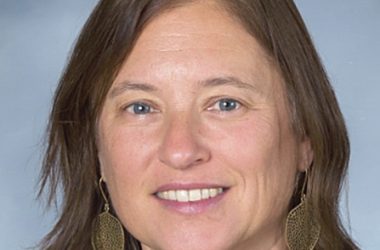
photo by Peter D’Auria/VTDigger
Water jugs at Sterling College in Craftsbury provide all the water for the college.
CRAFTSBURY – For just over two years, Craftsbury Academy, which educates roughly 140 students on its Craftsbury Common campus, has had no potable running water.
Instead of using fountains, students and staff drink from bottled water that is trucked in at the state’s expense. But it’s not only drinking water that’s affected.
“They’re having to pour water out of bottles to cook with and all of that, which makes it a little more challenging,” said Joe Houston, the Orleans Southwest Supervisory Union’s facilities director. “Dealing with bottles and bubblers, and making sure that water deliveries come on time and get refilled, is just one more complication to the operation.”

photo by Peter D’Auria/VTDigger
Joe Houston, the Orleans Southwest Supervisory Union facilities director, in the Craftsbury Academy gym, deals with water deliveries and distribution.
The reason? Tests have detected toxic perfluoroalkyl and polyfluoroalkyl substances, also known as PFAS, in a Craftsbury public water system.
PFAS are toxic chemicals present in a variety of manufactured products, including electronics, construction products and fire-extinguishing foam. According to the Federal Environmental Protection Agency, PFAS can increase the risk of cancers and have a range of negative impacts on human health.
It’s not clear how the contaminants got into Craftsbury’s water. But Craftsbury Academy’s workarounds are an example of how some schools with hundreds of students have had to adapt to life without potable running water, in some cases for years.

photo by Peter D’Auria/VTDigger
Water fountains at Craftsbury Academy post the Do Not Drink Order.
Under a 2019 Vermont law, public water systems that serve 25 or more people, are required to test for PFAS regularly. And schools, many of which depend on their own individual public water system, are bearing an apparently disproportionate PFAS burden.
“There are approximately 150 schools in Vermont that are (on) their own public drinking water system,” said Ben Montross, drinking water program manager at the Department of Environmental Conservation. “So they’re served by their own on-site well. And because they serve a public population of more than 25 people, they’re regulated as a public system.”
Montross said that small, rural schools are likely more susceptible to PFAS contamination because they may have both water and septic systems on-site.
At those schools, “floor waxes, floor polishes, floor cleaners and various other chemicals that would be used as part of the cleaning and maintenance processes would then wash down the drain,” Montross said, giving a hypothetical example. “And the drain would go into the on-site septic (system), and then the PFAS would travel through the aquifer into the drinking water system.”
The public water system currently under a Do Not Drink Order in Craftsbury serves both Craftsbury Academy and Sterling College, according to a spreadsheet of state data provided by Montross. The data does not include information about small private and residential properties, only public water systems.
“Over time — you know, it’s now been just about two years — over time, we all kind of got into a rhythm of it,” said Nicole Civita, a Sterling College administrator and a commissioner on a Craftsbury fire district board, which oversees the water system. “So the water truck comes in, somebody notices, and a whole bunch of Sterling staff or students get out and volunteer to offload jugs.”
Mount Holly Elementary School and Woodbury Elementary School are under similar orders because of PFAS levels, according to the data. Mt. Holly, which educates about 110 pre-K-6 students, has been under the order since December 2019. Woodbury, a roughly 55-student elementary, has been under the order since November 2022.
In Woodbury, officials are working to determine the source of the contamination so a new system can be installed, and at Mount Holly, a “new well and treatment design” is in the works, according to the state spreadsheet.
The Dover child care facility Kids in the Country and the Morgan independent Turning Points School are also under Do Not Drink orders due to PFAS. Kids in the Country has been without potable tap water since 2020, while Turning Points has gone without since 2021. A sports bar in Killington and a mobile home park in Rockingham also exceed PFAS limits in their water, according to the data.
The town of Morgan owns the school building occupied by Turning Points, a therapeutic school with about 30 students, and the town pays for the water.
“It’s hundreds of dollars a month,” said Eric Pope, the chair of the Morgan select board. “But it’s not astronomical.”
Pope said that PFAS had been detected at other private properties nearby Turning Points. The town is planning to drill a new well that Pope hopes will be PFAS-free, he said, and if all goes well, clean water could be flowing by the summer.
Tasha Tobey-Pike, the assistant director of Kids in the Country, in Dover, said she believed the nonprofit child care center was paying out of pocket for bottled water.
Using bottled water could be an “inconvenience” if the nonprofit ran out during the day, she said. And “with us paying for it out of pocket, it is an added cost that we wouldn’t typically incur.”
The state has implemented an upper limit when it comes to PFAS contamination in water: 20 nanograms per liter. No current federal limit exists, but the federal Environmental Protection Agency expects to release its first PFAS regulation limits early this year.
Anyone following the state’s ongoing saga around polychlorinated biphenyls, aka PCBs, in Vermont schools may see parallels with PFAS.
The story has a similar shape: Vermont releases regulations about the permitted concentrations of a toxic chemical that are more stringent than federal ones. And in schools, the detection of that toxic chemical requires mitigation and raks up costs.
Luckily, however, the presence of PFAS has not been nearly as disruptive to schools as PCBs. For one thing, the short-term remedy consists of simply trucking in bottled water not, for example, rebuilding a school from scratch, as is happening with the contaminated Burlington High School.
But PFAS still has its costs. As of early November, according to Montross, the state had paid out $88,000 to purchase bottled water for systems affected by PFAS. Of that sum, $66,000 went to Craftsbury alone.
Civita, of Sterling College and the Craftsbury Common fire district, expressed gratitude that the state was picking up the water tab. Without that, she said, the cost would have been “tremendously burdensome” for customers, including Craftsbury Academy and Sterling.
In Craftsbury, however, there may be light at the end of the tunnel. Tests from a newly drilled well have come back clean, meaning that with luck, bottled water could be on its way out.
“Hopefully, sometime this summer, drinkable water will start flowing through the taps again in Craftsbury Commons,” Civita said.







